Fact Sheet FS1307
What Is Stormwater?
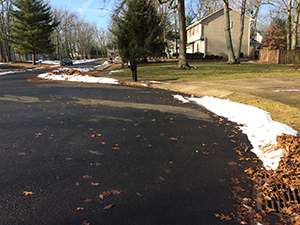
Figure 1. Snowmelt is also stormwater. As temperatures rise, the melting snow carries leaves, road salt, and sand to the storm drain in Jackson, NJ.
Stormwater is any form of water that begins as precipitation. This includes rain, sleet, snow, and the water from melting snow, even if the melting occurs long after the snowstorm had passed (Figure 1).
There are a few general outcomes for precipitation:
Why Is It Important to Manage Stormwater?
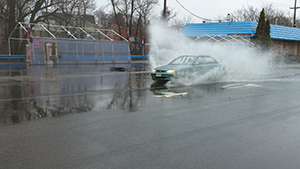
Figure 2. Unmanaged stormwater can lead to localized flooding and hazardous driving conditions, as seen on this road in Paterson, NJ.
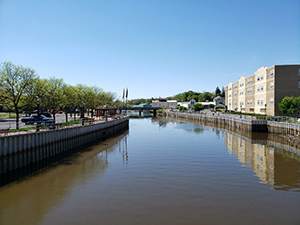
Figure 3. Some urban areas are built along rivers so that stormwater runoff flows directly to the river without intervening detention basins or green infrastructure. Here, outfall pipes for stormwater can be seen in the flood walls. The Cohansey River in downtown Bridgeton, NJ.
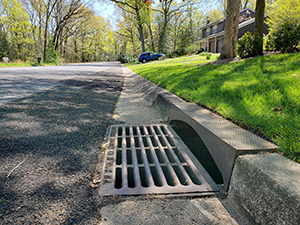
Figure 4. A storm drain in a residential neighborhood in Upper Deerfield, NJ. Stormwater runoff from the road and residences is collected by the storm drain. In this case, the runoff then flows by underground pipe to a nearby detention basin.
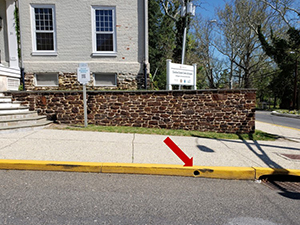
Figure 5. In some urban and suburban settings, stormwater runoff from building roofs is collected by downspouts and piped below the lawn and sidewalks to the street. Here, the outlet to the street is the round hole in the yellow curb to the left of the storm drain on the road. In these cases, stormwater from the roof passes to the municipal stormwater system without being detained or absorbed by the lawn. Rutgers Cousteau Center in Bridgeton, NJ.
How Is Stormwater Managed in New Jersey?
Direct Discharge and Detention Basins
In some cases, such as where there are urban areas or properties adjacent to a waterbody, stormwater runoff may flow more or less directly into the waterbody (Figure 3). Other communities may have a system of storm drains along streets and parking lots that deliver runoff almost directly to a local waterbody by a series of underground pipes (Figure 4; Figure 5). Stormwater runoff is usually not treated in this case, except where there may be a filter to prevent debris and trash from entering the drainage system or the waterbody itself.
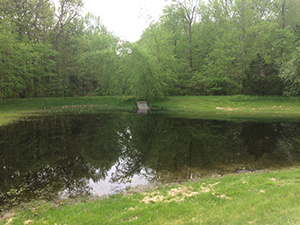
Figure 6. A stormwater detention basin in a residential neighborhood in East Windsor, NJ. An overflow structure is located in the background center. Improperly functioning detention basins can have standing water that can lead to further flooding and mosquito breeding areas. The bottom and sides of the basin are maintained as mowed turf.
Stormwater runoff may be piped to a detention basin for temporary storage before discharge to a waterbody, as can be seen in many residential developments and shopping centers. Detention basins are typically designed to hold water temporarily, so that it drains to a local waterbody more slowly. The goal is to decrease the likelihood of downstream flooding and slow the water level rise in the receiving waterbody. Detention basins are often maintained as areas of turfgrass or other vegetation, to allow some water to percolate into the soil as well (Figure 6). Other related options include retention basins (with a permanent pool of water) and infiltration basins, which allow percolation of stormwater into the ground.
Combined Sewage and Stormwater Systems
Sewage from households and businesses is typically handled in completely separate pipes from stormwater runoff. Sewage is sent to a wastewater treatment plant where it undergoes several steps of treatment before eventually being discharged.
In some of the state's oldest cities, however, the stormwater and sanitary sewer systems are combined in a single pipe, a technology dating from the late 1800s and early 1900s. When there is no rain, household and commercial waste flows to the sewage treatment plant and is treated before being released into the receiving waterbody. When it is raining, the wastewater treatment plant is tasked with treating the combined volume of stormwater and wastewater. Under conditions of limited stormwater runoff, this results in stormwater being treated before it is discharged. However, in cases of larger storms, the treatment system can be overwhelmed and so the excess flow is discharged without treatment to a local receiving waterbody. Reducing the incoming stormwater volume can decrease the frequency and volume of combined sewer overflows in these systems.
Green Infrastructure
Stormwater can also be managed on-site before it becomes runoff through use of best management practices, such as green infrastructure. Green infrastructure reduces the volume of stormwater runoff from the site by capturing and holding, reusing, or infiltrating stormwater back into the soil. Green infrastructure practices include pervious pavement, rain gardens, vegetated swales, and rain barrels. Green infrastructure is often considered a good approach for managing stormwater because it reduces the amount of stormwater runoff at the source, decreasing the negative effects of large stormwater flows and reducing the amount of infrastructure needed for transport or treatment.
Who Manages Stormwater in New Jersey?
Nearly all municipalities have some amount of stormwater systems or combined sewers. Highway agencies and public works departments at the county and state levels also manage stormwater. Stormwater infrastructure is typically funded through property taxes. Some landowners such as business parks, residential developments operated by homeowner associations, and some educational institutions often have privately-owned stormwater systems.
What Is the 'Clean Stormwater and Flood Reduction Act'?
The Act authorizes municipalities, counties, or groups of municipalities to establish and operate local fee-based stormwater utilities. These utilities can also be established and operated by sewerage authorities and improvement authorities. Stormwater utilities are allowed to collect fees to finance the operation of the utility and the improvement of stormwater infrastructure. Municipalities, counties, and authorities would be allowed to contract with private firms for the operation or improvement of stormwater utilities.
The stated goals of the Act include:
In addition, the Act requires that the New Jersey Department of Environmental Protection (NJDEP) create a Guidance Manual that would provide rate structure information, including the means and method of computing rates for stormwater utilities; technical assistance for establishing a stormwater utility; and providing direction for public education efforts.
Under this Act, NJDEP would receive up to 5% of fees collected from stormwater utilities. These funds would be used for planning, implementation, and coordination activities related to the stormwater utilities program, as well as to conduct water quality monitoring, undertake public education, and implement stormwater reduction projects.
What Is a Stormwater Utility?
A stormwater utility is a funding mechanism to pay for the costs of stormwater-related services and improvements provided to a community. The key point is that the necessary work of managing stormwater is funded by stormwater fees instead of property taxes. It does not need to be a new agency, department, board, or group of people.
Similar to an entity handling a community's need and usage of electricity, gas, and water, a stormwater utility would collect fees for the implementation of stormwater planning and control programs. Specifically, a stormwater utility would be tasked with acquiring, constructing, maintaining, and operating a stormwater management system.
Who Would Be Charged a Stormwater Utility Fee?
Fees can be assessed on owners and occupants of land, including homeowners, renters, and business owners. According to the Act, fees are to be proportionate to the contribution of stormwater runoff from a property.
Properties that use best management practices for their stormwater management may receive a discount as an incentive to install green infrastructure. These practices should reduce, retain, or treat stormwater onsite.
Properties that are farmland assessed will not be charged stormwater utility fees.
When Does the Act Take Effect?
The Governor of New Jersey signed the bill into law on March 18, 2019, and much of the law will take effect 6 months after the date of enactment, September 18, 2019. The New Jersey Department of Environmental Protection may take actions prior to this 6-month deadline, as needed, to initially and fully implement this act.
Will I Be Charged a Stormwater Fee?
The law authorizes but does not require creation of a stormwater utility. Only if municipalities, counties, and authorities create a stormwater utility would property owners be charged a fee based on the amount of runoff generated from their property. There are many steps required before a fee would be charged, including a community determining whether a stormwater utility makes sense for that area, creating that utility, and then implementing the fee structure.
Where Can I Go to Get More Information on Stormwater Management?
Photo credits: Steve Yergeau (Figures 1 and 6), Amy Rowe (Figure 2), Sal Mangiafico (Figures 3–5).
July 2019
Copyright © 2025 Rutgers, The State University of New Jersey. All rights reserved.
For more information: njaes.rutgers.edu.
Cooperating Agencies: Rutgers, The State University of New Jersey, U.S. Department of Agriculture, and Boards of County Commissioners. Rutgers Cooperative Extension, a unit of the Rutgers New Jersey Agricultural Experiment Station, is an equal opportunity program provider and employer.

